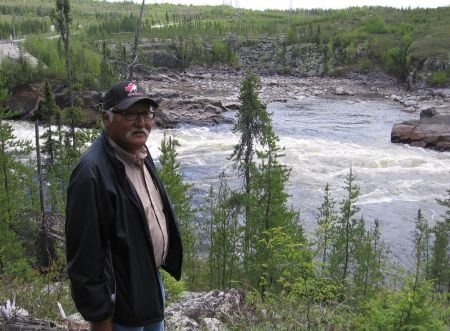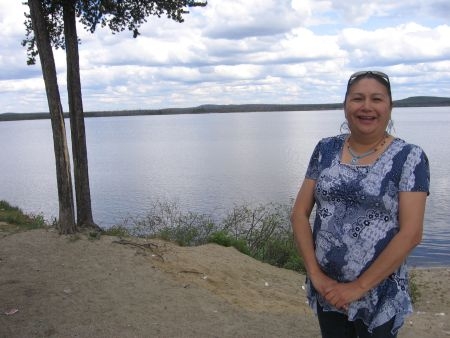Big Hydro: Going To The Source

(Host) For centuries, the native Cree people of northern Quebec subsisted largely on hunting, fishing and trapping.
But the coming of huge hydroelectric projects in James Bay 40 years ago changed that way of life. Whole villages were moved. Hunting and trapping grounds were flooded. Rivers were diverted and rerouted.
The Cree fought the ever-expanding reach of Hydro-Quebec until just a few years ago when the provincial utility promised huge financial payments.
That’s produced a new prosperity. But as VPR’s John Dillon explains in this part of our series on "Big Hydro," it’s also brought new cultural challenges.
(Pizza delivery!)
(Dillon) In the Cree village of Nemaska, kids rush through a school hallway carrying boxes of pizza for their classmates.
(Diamond) "I’m just going to step out to the post office."

(Dillon) Lillian Jolly Diamond is the principal. She’s worked in the school system for 25 years, and her roots in the community are deep. As a child, her family had to move from her village because of a Hydro-Quebec project.
(Diamond) "That in itself was devastating. I was only 10 years old at the time when it happened. So the community was split. We had to basically start our life all over, in a different community, different school, different everything."
(Dillon) Diamond’s late father followed the traditional way of life, working trap lines in winter and hunting and fishing for food. Last spring, she went with her brother to camp on her father’s old trap line. She’s struck by how so much of the hunger generation has moved away from living off the land.
(Diamond) "And I think that’s what is lost, is the connection to the land when all this is going on around us."
(Dillon) In the early 1970s, Hydro-Quebec began the James Bay power projects with little input or consent from the Cree community. But after a series of legal challenges, the two sides agreed in 2002 to work together.
Vermont lawyer James Dumont represented the Cree in the 1980s and ‘90s as Vermont considered an earlier Hydro-Quebec power contract. Dumont says the Cree are much more in control now.
(Dumont) "The democratically elected leadership of the Crees now deals with the democratically elected leadership of Quebec. And this is the arrangement they have made. And if the Cree community through their elected leadership says we want certain projects to go forward, that’s their right."
(Dillon) Under the latest agreement, the 15,000 Cree of northern Quebec get $70 million dollars a year for 47 years. The money does not go directly to individuals. Some has been invested, and other funds go to the tribal authority for housing, school construction, and a variety of business and development organizations.
The Cree have their own airline, and some who still live off the land can use helicopters and float planes to travel to their hunting grounds. But according to Roger Orr, a Cree drug and alcohol counselor, the affluence has also resulted in damaged lives.
(Orr) "It’s not the answer to what it is that we need. The suicide rate is very high, the alcoholism, the drug abuse and the loss of an identity."
(Dillon) Orr is a student of sociology who still relies on traditional healing ceremonies in his work. And he says the Hydro-Quebec money has created what he calls a culture of dependency. Many people work for the government or tribal organizations. Orr says they no longer have to rely on themselves to find work or food.
(Orr) "So the work ethics, they disappear, because you can practically do whatever you want in the end and not produce due to the fact that the money comes in at the end of the fiscal year. You get a new bundle of money. So for the last 30 years people have been working for these entities and the mindset of what work is all about is to come and go as you please."
(Dillon) Lawrence Jimikin has another view of the community. Jimikin is a Cree liaison with Hydro-Quebec. He acknowledges the social problems, but says Hydro-Quebec has provided construction and service jobs as the latest project was built.
(Jimikin) "There’s been approximately $240 million in guaranteed contracts that went directly to native companies. There are native companies that have benefited."

(Dillon) One of those who got hired is Steven Visitor, a 20 year old Cree who’s studying engineering. He appreciates that he can find a good construction job yet still live close to the wilderness.
(Visitor) "I like Nemaska. It’s very peaceful and quiet and relaxing. You can go fish anywhere, or hunt. It’s not really like the city. I’m not really a city person. I love the bush, staying in the bush. And where I’m working is in the bush, too."
(Dillon) But Visitor is ambivalent about the overall impact of the hydro projects. Because he remembers how it used to be.
(Visitor) "Where I’ve seen the water, most of the places I’ve seen, the rapids are all down. And I used to go fish there. I used to love seeing it and now it’s like – how do I say this – it’s all sad seeing it. It breaks my heart seeing something like that."
(Dillon) Lillian Jolly Diamond, the school principal, says the Cree have made the best of the Hydro-Quebec development.
(Diamond) "I don’t know how many other aboriginal nations have their own school board, their own health board, their own Cree construction companies. All these things that we reaped out of the funding that we’re getting. That’s another benefit that we’re getting. And with that we’re able to provide our own economic development for our own people."
(Dillon) It’s a balance, she says. Traditional ways are followed by fewer and fewer. But she believes the Cree may have found a new way to support their very old culture.
(Dillon) For VPR News, I’m John Dillon.